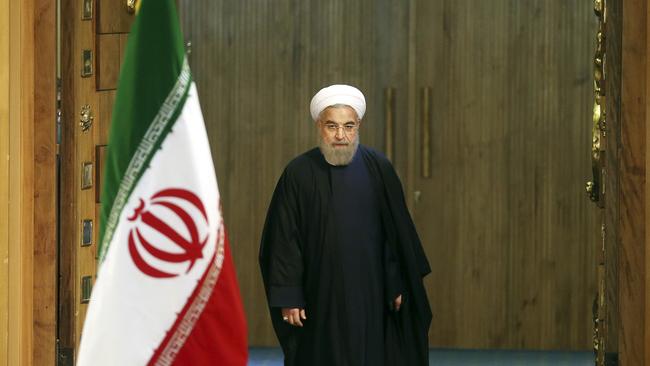The great Iranian geopolitical gamble
Geopolitical realignment has far-reaching consequences.

The shock waves have already begun to ripple from US President Barack Obama’s biggest Middle East gamble, in which more than three decades of enmity have been put aside as the “Great Satan” reaches out to embrace Iran.
The weekend lifting of sanctions over Iran’s nuclear program and synchronised release of US prisoners in Iran is the visible proof of a much bigger geopolitical realignment in the Middle East, with far-reaching, but far from certain, ramifications.
But critics both here and abroad warn that Iran remains an aggressive state that cannot — must not — be trusted not to welsh on its deals to decommission parts of its nuclear output and power down its aims for regional expansion.
Moderates in Iran led by President Hasan Rowhani acted quickly on US alliance demands to decommission parts of the nuclear program in the hope financial relief will translate into political support in elections next month.
As a result, world powers delivered on promises to lift a raft of crushing sanctions against Iran. Hours earlier, Iran released five Americans it had detained, including Washington Post reporter Jason Rezaian, after a year of delicate negotiations.
The lifting of sanctions has unlocked more than $US50 billion ($72.4bn) of Iranian money frozen in accounts around the world. The move was triggered by a report from the International Atomic Energy Agency verifying that Tehran has placed curbs on its nuclear program as agreed to in its deal in July with the US, Britain, France, Germany, Russia and China.
But within hours of the financial sanctions lifting, the US imposed a raft of new sanctions on 11 Iranian individuals and companies to punish Tehran for violating UN resolutions that prohibit ballistic missile tests.
President Obama said the sanctions prove the US will “remain vigilant” about curbing Iran’s development of medium and long-range missiles. “We’re not going to waver in the defence of our security or that of our allies and partners,” he said.
Critics lined up to warn of risks. “The investigation by IAEA is a technical investigation, which is flawed in some of its methods,” Victorian Labor MP Michael Danby said yesterday.
“It allows the nuclear site to collect samples and pass them on, which provides a basis for cheating,” the federal member for Melbourne Ports told ABC Radio.
The deal was criticised in the lead-up to the lifting of sanctions. US Secretary of State John Kerry was attacked for allowing Iran to keep previous nuclear activities classified. Iran is allowed to self-inspect the Parchin military base, where it is believed nuclear weapons research has taken place, and can use its own equipment and personnel to provide video surveillance, samples, and photos to the IAEA. Critics claim this allows Iran’s Supreme Leader Ayatollah Khamenei to keep military sites such as Parchin off limits.
In addition, Iran is able to delay inspectors for 24 days before the IAEA can visit a suspicious site.
On Sunday, Israeli Prime Minister Benjamin Netanyahu said Israel would continue to monitor Iran for any violations. Briefing his cabinet, Netanyahu called for harsh, aggressive sanctions for any violation by Iran. “Were it not for our efforts to spearhead the sanctions and foil Iran’s nuclear program, Iran would have already had nuclear weapons long ago.
“Israel’s policy was and remained exactly the same: to not let Iran achieve nuclear weapons. It is clear that from now on Iran will have more means to use for its terror and aggression activity in the region and in the world. And Israel is ready to cope with any threat.”
US presidential candidate Hillary Clinton said that as president her policy towards Iran would be to “distrust and verify”.
“I too am deeply concerned about Iranian aggression and need to confront it,” she said. “There is absolutely no reason to trust Iran.”
The Iran deal has been a journey of mutual convenience for Obama, who wants a Middle East legacy, and Rowhani, who seeks tangible relief from sanctions for his constituents before parliamentary elections on February 26.
The election is widely viewed as a referendum on the moderate leader, who is not without his hardline detractors at home.
Western leaders prefer Rowhani over his right-wing predecessor, Mahmoud Ahmadinejad, and made plain that if sanctions relief helps the current President’s electoral prospects, it’s just another benefit of the landmark nuclear deal.
“We hope that (Rowhani) will garner some support because of the sanctions relief,” German ambassador to the US Peter Wittig told reporters.
Under Obama, the US has clearly calculated it is better to have Iran inside the tent amid a worsening regional security outlook, which is exporting rising refugee numbers and extremist terror to the world. The prospect of strengthened relations between the US and Iran has already had profound ramifications that are shaking the global economy.
The collapse in global oil price to below $US30 a barrel is in large measure a barometer of the changing political dynamic in the Middle East.
Conventional wisdom is that Saudi Arabia collapsed the price of oil in late 2014 in a bid to defend market share and drive US shale producers out of business.
Others believe Saudi Arabia’s policy to flood world oil markets was designed to reassert its regional dominance, punish enemies and rob Iran of the financial benefits from the lifting of US sanctions.
Iran has huge stockpiles of oil ready to export now that sanctions are lifting and plans to increase production by one million barrels a day.
But Saudi Arabia has signalled a long war of attrition with sweeping economic reforms to wind back the oil-funded welfare state, including the possible partial float of its state-owned oil reserves, which would become the biggest listed company in the world.
The nexus between Saudi Arabia, US shale and changing geopolitical forces in the Middle East is impossible to ignore. But it is more complex than often portrayed. One view from Tehran is that a new detente with the Great Satan was made possible because the huge increase in US shale oil production had freed America from its dependence on Saudi crude.
Breaking its dependence on Middle Eastern oil has been a strategic imperative for the US since the first Gulf war, made possible by breakthroughs in drilling and fracking technology.
US shale oil producers are now under heavy financial pressure.
But all sides are firmly locked in a long-term gamble. Fawaz Gerges, a Middle East expert at the London School of Economics, says Iran’s attractions to the US are both political and economic. “There is a new relationship based on a new understanding of Iran’s pivotal role in the region — that Iran is here to stay,” he says.
The US would like Iran to play a positive role in stabilising the region. In particular, Tehran could be crucial in the fight against Islamic State in Iraq and Syria, and in finding an end to the civil war in Syria.
But the US’s traditional regional ally, Saudi Arabia, remains locked in increasingly bloody proxy battles with Iran, which has forged a Shia axis in an arc from Iraq through Syria to Lebanon.
Saudi Arabia also blames Iran for unrest in Bahrain as well as in Yemen.
According to Reuters analysis, Riyadh believes Tehran is stirring up Saudi Arabia’s Eastern Province, which contains nearly all the kingdom’s oil and most of its Shia minority.
There are many who argue the US has acted too quickly to bring Iran in from the cold. Much of the mistrust stems from Iran’s enduring hostility towards Israel and support for listed the terrorist organisation Hezbollah.
Danby told ABC Radio the peace deal with Iran may prove to be shortsighted.
“Iran still maintains a very aggressive regional policy in that part of the world,” he said.
“It still supports Hezbollah, which is recognised by the Australian government as a terrorist organisation.”
Under the terms of the deal to scale back its nuclear program, Iran must allow continuous monitoring, including electronic surveillance and spot inspections by the IAEA, the Vienna-based global nuclear watchdog.
Iran must also remove and decommission the core of its heavy water nuclear reactor at Arak, 258km southwest of the capital Tehran, and redesign the reactor so it produces far less plutonium fuel than originally planned.
It has agreed to reduce to no more than 5060 for 10 years the number of uranium enrichment centrifuges at its nuclear facility near Natanz. Iran has also agreed to limit for at least 10 years research and development on centrifuges and the locations where it can occur.
Iran will limit uranium enrichment to no more than 3.67 per cent for 15 years, well below weapons grade. It pledges to reduce its stockpile of reactor-grade uranium to a maximum of 300kg.
It also accepts a joint commission — a majority of whose members are representatives of the US and its European partners France, Britain and Germany — for resolving disputes over implementation of the accord.
In exchange, UN sanctions have been lifted, including asset freezes that targeted Iran’s defence and shipping industries and its nuclear scientists. A UN embargo on the export of most conventional weapons to Iran remains, but Tehran can obtain arms and related components and services with the specific approval of the UN Security Council.
Other nuclear-related US and European Union sanctions have been lifted that have limited Iran’s international trade, especially its sale of oil and gas.
The lifting of sanctions means foreign oil companies are free to enter Iran’s energy market, with Europe poised to become a big customer.
Iran has access to what its central bank estimates is some $US30 billion in revenue from the sale of oil and gas to China, South Korea, Japan and other Asian countries. Transfer of the revenue has been frozen by international sanctions. The full ramifications of the thaw in US Iran relations will play out for decades to come. But harsh critics argue it has come too soon.
“In five years’ time Iran has $100bn of reserves freed up and is able to buy whatever conventional weapons on the open market that it likes,” Danby said.
Additional reporting: The Wall Street Journal and agencies



